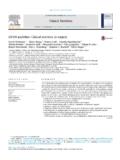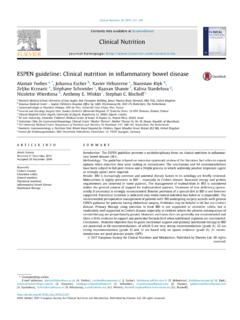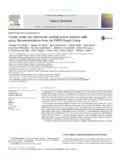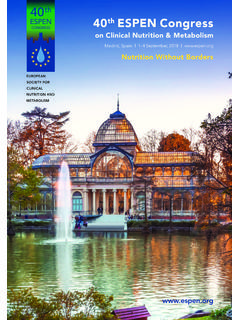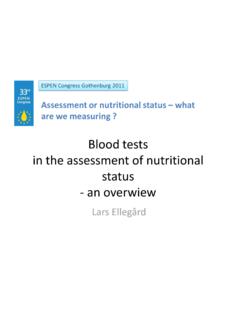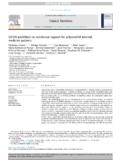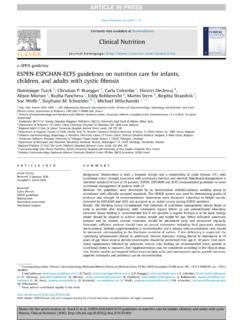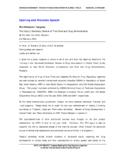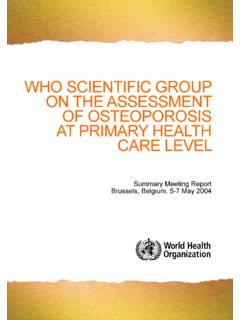Transcription of ESPEN guidelines on definitions and terminology …
1 ESPEN GuidelineESPEN guidelines on definitions and terminology of clinical nutritionT. Cederholma,*, R. Barazzonib, P. Austinc,y, P. Ballmerd, G. Bioloe, Bischofff,C. Compherg,1, I. Correiah,1, T. Higashiguchii,1, M. Holstj, Jensenk,1, A. Malonel,1,M. Muscaritolim, I. Nyulasin,1, M. Pirlicho, E. Rothenbergp, K. Schindlerq, Schneiderr, de van der Schuerens,z, C. Siebert, L. Valentiniu, Yuv,1,A. Van Gossumw, P. SingerxaDepartments of Geriatric Medicine, Uppsala University Hospital and Public Health and Caring Sciences, clinical Nutrition and Metabolism, UppsalaUniversity, Uppsala, SwedenbDepartment of Medical, Surgical and Health Sciences, University of Trieste, Trieste, ItalycPharmacy Department, Oxford University Hospitals NHS Foundation Trust, United KingdomdDepartment of Medicine, Kantonsspital Winterthur, Winterthur, SwitzerlandeInstitute of clinical Medicine, University of Trieste, Trieste.
2 ItalyfInstitute of Nutritional Medicine, University of Hohenheim, Stuttgart, GermanygSchool of Nursing, University of Pennsylvania, Philadelphia, PA, USAhDepartment of Surgery, Federal University of Minas Gerais, Belo Horizonte, BraziliDepartment of Surgery and Palliative Medicine, Fujita Health University, School of Medicine, Toyoake, JapanjCenter for Nutrition and Bowel Disease, Department of Gastroenterology, Aalborg University Hospital, Aalborg, DenmarkkThe Dean's Office and Department of Medicine, The University of Vermont College of Medicine, Burlington, VT, USAlPharmacy Department, Mount Carmel West Hospital, Columbus, OH, USAmDepartment of clinical Medicine, Sapienza University of Rome, ItalynNutrition and Dietetics, Alfred Health, Melbourne, AustraliaoDepartment of Internal Medicine, Elisabeth Protestant Hospital, Berlin, GermanypDepartment of Food and Meal Science, Kristianstad University, Kristianstad.
3 SwedenqDepartment of Internal Medicine III, Division of Endocrinology and Metabolism, Medical University Vienna, Vienna, AustriarDepartment of Gastroenterology and clinical Nutrition, Archet Hospital, University of Nice Sophia Antipolis, Nice, FrancesDepartment of Nutrition and Dietetics, Internal Medicine, VU University Medical Center, Amsterdam, The NetherlandstInstitute for Biomedicine of Ageing, Friedrich-Alexander University Erlangen-N rnberg, Hospital St. John of Lord, Regensburg, GermanyuDepartment of Agriculture and Food Sciences, Section of Dietetics, University of Applied Sciences, Neubrandenburg, GermanyvDepartment of General Surgery, Peking Union Medical College Hospital, Chinese Academy of Medical Sciences and Peking Union Medical College, Beijing,ChinawDepartment of Gastroenterology, Clinic of Intestinal Diseases and Nutritional Support, Hopital Erasme, Free University of Brussels, Brussels, BelgiumxDepartment of Critical Care.
4 Institute for Nutrition Research, Rabin Medical Center, Sackler School of Medicine, Tel Aviv University, Petah Tikva 49100 IsraelyPharmacy Department, University Hospital Southampton NHS Foundation Trust, United KingdomzDepartment of Nutrition, Sports and Health, Faculty of Health and Social Studies, HAN University of Applied Sciences, Nijmegen, The Netherlandsarticle infoArticle history:Received 9 September 2016 Accepted 9 September 2016 Keywords:TerminologyDefinitionsummaryBac kground:A lack of agreement on definitions and terminology used for nutrition-related concepts andprocedures limits the development of clinical nutrition practice and :This initiative aimed to reach a consensus for terminology for core nutritional concepts.
5 The European Society of clinical Nutrition and Metabolism ( ESPEN ) appointed a consensusgroup of clinical scientists to perform a modified Delphi process that encompassed e-mail communi-cation, face-to-face meetings, in-group ballots and an electronic ESPEN membership Delphi round.*Corresponding author. clinical Nutrition and Metabolism, Public Health and Caring Sciences, Uppsala University, Uppsala Science Center, Dag Hammarskj oldsv ag 14B, 75185 Uppsala, de vander Van Singer).
6 1 Global co-authors contributing late in the lists available atScienceDirectClinical Nutritionjournal homepage: 2016 European Society for clinical Nutrition and Metabolism. Published by Elsevier Ltd. All rights Nutrition 36 (2017) 49e64 ConsensusMalnutritionClinical nutritionMedical nutritionResults:Five key areas related to clinical nutrition were identified: concepts; procedures; organisation;delivery; and products. One core concept of clinical nutrition is malnutrition/undernutrition, which in-cludes disease-related malnutrition (DRM) with (eq.)
7 Cachexia) and without inflammation, and malnu-trition/undernutrition without disease, hunger-related malnutrition. Over-nutrition (overweight andobesity) is another core concept. Sarcopenia and frailty were agreed to be separate conditions oftenassociated with malnutrition. Examples of nutritional procedures identified include screening for sub-jects at nutritional risk followed by a complete nutritional assessment. Hospital and care facility cateringare the basic organizational forms for providing nutrition.
8 Oral nutritional supplementation is thepreferred way of nutrition therapy but if inadequate then other forms of medical nutrition therapy, tube feeding and parenteral (intravenous) nutrition, becomes the major way of nutrient :An agreement of basic nutritional terminology to be used in clinical practice, research, andthe ESPEN guideline developments has been established. This terminology consensus may help tosupport future global consensus efforts and updates of classification systems such as the InternationalClassification of Disease (ICD).
9 The continuous growth of knowledge in all areas addressed in thisstatement will provide the foundation for future revisions. 2016 European Society for clinical Nutrition and Metabolism. Published by Elsevier Ltd. All IntroductionNutrition plays a pivotal role in life and in medicine. Acute andchronic diseases in most organ systems have pronounced effects onfood intake and metabolism with increased catabolism, which leadto nutrition-related conditions associated with increased morbidityand eventually death.
10 At the other end of the spectrum, diet is amajor determinant of future health, the absence or post-ponement of disorders like cardio-vascular disease, diabetes, can-cer and cognitive disease[1].In order to handle nutritional challenges during disease, trauma,rehabilitation, and elderly care as well as for the nutritional pre-vention of disease it is essential to use professional language andstandard terminology that is founded on evidence and widelyaccepted in the professional community. However, this is not al-ways the case.
